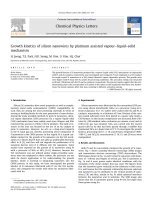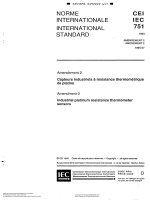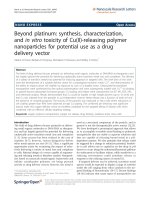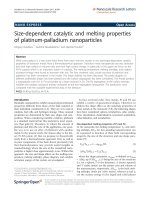Platinum pps
Bạn đang xem bản rút gọn của tài liệu. Xem và tải ngay bản đầy đủ của tài liệu tại đây (537.53 KB, 23 trang )
Platinum Group Elements
AJ Appleby, Texas A&M University, College Station, TX, USA
& 2009 Elsevier B.V. All rights reserved.
Introduction
Electronic Structure
The platinum group metals occupy the second and third
rows of periodic table Group VIII, the first row of which
consists of iron (Fe), cobalt (Co), and nickel (Ni). The
second-row elements ruthenium (Ru), rhodium (Rh), and
palladium (Pd) all have the krypton (Kr, inert gas, atomic
number 36) core of completed electron shells and sub-
shells (see Chemistry, Electrochemistry, and Electro-
chemical Applications: Oxygen). With n as the principal
quantum number, these are (n ¼1): (shell K, subshell 1s
2
);
(n ¼2): (shell L, subshells 2s
2
,2p
6
), (n ¼3): (shell M,
subshells 3s
2
,3p
6
,3d
10
), (n ¼4): (shell N, subshells, 4s
2
,
4p
6
). It should be noted that subshells s, p, d, f, y rep-
resent those with angular or azimuthal quantum number
l ¼0, 1, 2, 3, 4, y. Following the completed shells and
subshells in krypton, the subsequent elements first start
filling shell O, subshell 5s, in alkali metal Group I
element 37, rubidium Rb, then with two in alkaline earth
Group IIA element 38, strontium Sr. Subshell 5s can only
accommodate two electrons, so the previously un-
occupied shell N, subshell 4d, the next highest in energy,
is filled next. It should be noted that shell N, subshell 4f,
which is of still higher energy, is as yet unoccupied
compared with shell O, subshell 5s. Then shell N, sub-
shell 4d, is filled by one electron at a time from element
39, yttrium, Y, to the next element zirconium, 40, Zr.
Following this, electrons are exchanged between shell N,
subshell 4d, and shell O, subshell 5s because of similar
energies. Thus element 41, niobium, Nb, has four elec-
trons in subshell 4d, and only one in subshell 5s. This
continues until element 43, technecium, Tc, which has
six subshell 4d electrons and again one in subshell 5s. We
now arrive at the first-row platinum metal, element 37,
Ru, with seven electrons in subshell 4d, and one in
subshell 5s; element 38, Rh, with eight in 4d and again
one in 5s; and finally element 39, Pd with ten in 4d and
none in 5s. This is followed by element 40, silver, Ag
(from the Latin word argentum), in Group IB, which has
the inner electronic structure of Pd with one 5s electron.
Following this, 5s and 5p are filled until the next inert
gas electronic configuration with fully completed shells,
element 54, xenon, Xe, is reached. It has completed s and
p shells with 2 and 6 electrons, respectively. Group IA
element 55, caesium, Cs, then follows by having one
electron in shell P, subshell 6s. Group IIA element 56,
barium, Ba, follows with two electrons to complete this
subshell, the arrangement corresponding to that for Rb
and Sr discussed above.
Having filled shell P, subshell 6s, the rare earth element
lanthanum, La, adds an electron to complete shell O,
subshell 5d. Successive one-electron additions to shell N,
subshell 4f, which has previously been empty, then suc-
cessively occur until rare earth element 71 lutecium, Lu, is
reached, to give its maximum occupancy of 14 electrons.
This results in very large progressive downward change in
atomic volume (Ba, 36.34 cm
3
g-atom
À1
;La,22.6;element
76, osmium, Os, 8.49). This is known as the lanthanide
contraction. In all the metal of the rare earth series, sub-
shell 5d contains only one electron. We now arrive at the
electron core of element 72, hafnium, Hf, which has the
lutecium arrangement but with two 5d electrons. The
hafnium core to the 5p subshell provides the basis of the
inner electronic structure of the third-row Group VIII
platinum metals. After Hf, tantalum, Ta (element 73) adds
a further 5d electron to give a total of 3. They are further
added through tungsten, W (element 74), and rhenium, Re,
75. Os (element 76), the first third-row Group VIII
element has 6. However, in element 77, iridium, Ir, a lower
energy state results from combining its two 6s electrons
with its seven 6d electrons to give a total of nine 6d
electrons. Platinum, Pt (element 78) has the same 9 elec-
tron 6d configuration, but with an additional 6s electron.
Chemical Properties Resulting from
Electron Configurations
First Row: Iron, Cobalt, and Nickel
The first-row Group VIII metals Fe, Co, and Ni are
typical transition metals. Their atomic weights are 55.85,
58.93, 58.69; their room temperature specific gravities are
7.86, 8.90, 8.90; and their MPs (MPs) are 1535, 1495, and
1455 1C, respectively. Their atomic volumes (cm
3
g-
atom
À1
) are 7.43, 7.11, and 6.76, respectively. They are all
face-centered cubic. They all oxidize in water close to the
reversible hydrogen potential. For the metals, the po-
tentials given below are standard states at 25 1C, in water
in the absence of complexing agents, taken from M.
Pourbaix’s Atlas of Electrochemical Equilibria in Aqueous So-
lutions (at 25 1C). For example, the Fe–FeO (Fe
2þ
) tran-
sition is at À0.047 V vs HE (the reversible hydrogen
electrode in the same solution). This is followed by for-
mation of the mixed valence oxide FeO ÁFe
2
O
3
(mag-
netite, Fe
3
O
4
)at À0.085 V vs HE. Fe
2
O
3
(Fe
3þ
) forms at
853









